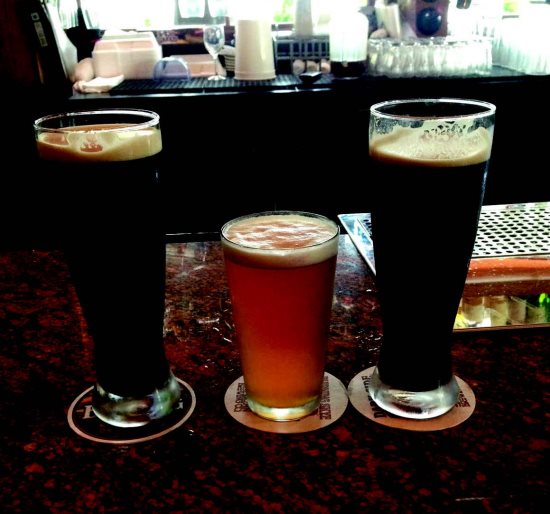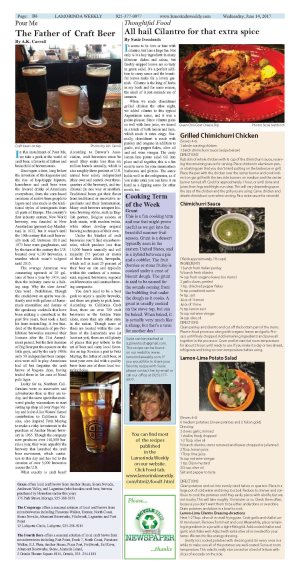| | Published June 14, 2017
| Pour Me
| | The Father of Craft Beer | | By A.K. Carroll |  | | Craft beers on tap. Photos by A.K. Carroll |
In this installment of Pour Me, we take a peek at the world of craft beer, a favorite of fathers and brainchild of brewmasters.
 Once upon a time, long before the invention of the kegerator and the rise of hop-happy hipsters, homebrew and craft beer were the favored drinks of Americans everywhere, from the corn-based creations of native-born people to lagers and ales made in the traditional styles of immigrants from all parts of Europe. The country's first industry entrant, New World brewery, was founded in New Amsterdam (present-day Manhattan) in 1612, but it wasn't until the 19th century that craft beer really took off. Between 1810 and 1873 beer went gangbusters, and by the turn of the century the U.S. boasted over 4,100 breweries, a number which wasn't eclipsed until 2015.
Once upon a time, long before the invention of the kegerator and the rise of hop-happy hipsters, homebrew and craft beer were the favored drinks of Americans everywhere, from the corn-based creations of native-born people to lagers and ales made in the traditional styles of immigrants from all parts of Europe. The country's first industry entrant, New World brewery, was founded in New Amsterdam (present-day Manhattan) in 1612, but it wasn't until the 19th century that craft beer really took off. Between 1810 and 1873 beer went gangbusters, and by the turn of the century the U.S. boasted over 4,100 breweries, a number which wasn't eclipsed until 2015.
 The average American was consuming upwards of 20 gallons of beer a year by 1914, and then the industry came to a halting stop. Why the slow down? One word-Prohibition. Though the crackdown on spirits was defiantly met with gallons of homemade moonshine and dozens of the speakeasy cocktails that have been making a comeback in the past five years, beer took a hard hit from teetotalling. A few hundred of the thousands of pre-Prohibition breweries renewed their licenses after the 21st Amendment passed, but the first iteration of Big Beer put the squeeze on the little guys, and by the early 1980s only 50 independent beer companies were still in play. Americans had all but forgotten the craft brews of bygone days, having traded them in for cans of bland pale lager.
The average American was consuming upwards of 20 gallons of beer a year by 1914, and then the industry came to a halting stop. Why the slow down? One word-Prohibition. Though the crackdown on spirits was defiantly met with gallons of homemade moonshine and dozens of the speakeasy cocktails that have been making a comeback in the past five years, beer took a hard hit from teetotalling. A few hundred of the thousands of pre-Prohibition breweries renewed their licenses after the 21st Amendment passed, but the first iteration of Big Beer put the squeeze on the little guys, and by the early 1980s only 50 independent beer companies were still in play. Americans had all but forgotten the craft brews of bygone days, having traded them in for cans of bland pale lager.
 Lucky for us, Northern Californians were as innovative and adventurous then as they are today, and the same spirit that motivated plucky winemakers to start setting up shop all over Napa Valley and led to Alice Waters' famed contribution to California Cuisine, also inspired Fritz Maytag to make a risky investment in the purchase of Anchor Steam brewery in 1965. Though the company now produces over 164,000 barrels a year, they were arguably the brewery that launched the craft beer movement, which continues to this day and has led to the creation of over 5,000 breweries across the U.S.
Lucky for us, Northern Californians were as innovative and adventurous then as they are today, and the same spirit that motivated plucky winemakers to start setting up shop all over Napa Valley and led to Alice Waters' famed contribution to California Cuisine, also inspired Fritz Maytag to make a risky investment in the purchase of Anchor Steam brewery in 1965. Though the company now produces over 164,000 barrels a year, they were arguably the brewery that launched the craft beer movement, which continues to this day and has led to the creation of over 5,000 breweries across the U.S.
 What exactly is craft beer? According to Brewer's Association, craft breweries must be small (they make less than six million barrels annually, which is also roughly three percent of U.S. annual beer sales), independent (they own and control over three-quarters of the brewery), and traditional (in one way or another). Traditional beers get their flavor from traditional or innovative ingredients and their fermentation. Many craft brewers interpret historic brewing styles, such as English porters, Belgian saisons or Irish stouts, with modern twists, while others develop original brewing techniques of their own.
What exactly is craft beer? According to Brewer's Association, craft breweries must be small (they make less than six million barrels annually, which is also roughly three percent of U.S. annual beer sales), independent (they own and control over three-quarters of the brewery), and traditional (in one way or another). Traditional beers get their flavor from traditional or innovative ingredients and their fermentation. Many craft brewers interpret historic brewing styles, such as English porters, Belgian saisons or Irish stouts, with modern twists, while others develop original brewing techniques of their own.
 Under the blanket of craft breweries you'll find microbreweries, which produce less than 15,000 barrels annually and sell majority (75 percent or more) of their beer offsite, brewpubs, which sell at least 25 percent of their beer on site and typically within the confines of a restaurant, regional breweries, regional craft breweries and contract brewing companies.
Under the blanket of craft breweries you'll find microbreweries, which produce less than 15,000 barrels annually and sell majority (75 percent or more) of their beer offsite, brewpubs, which sell at least 25 percent of their beer on site and typically within the confines of a restaurant, regional breweries, regional craft breweries and contract brewing companies.
 You don't need to be a beer geek to enjoy a quality brewsky, and there are plenty to pick from. According to California Craft Beer, there are over 700 craft breweries in the Golden State alone, more than any other state in the nation. Though none of them are located within the confines of the Lamorinda area (at least not yet), there are still plenty of places that pay tribute to the art of beer and carry local favorites on tap. So raise a pint to Fritz Maytag, the father of craft beer, or toast your own dad with a quality brew from one of these local watering holes.
You don't need to be a beer geek to enjoy a quality brewsky, and there are plenty to pick from. According to California Craft Beer, there are over 700 craft breweries in the Golden State alone, more than any other state in the nation. Though none of them are located within the confines of the Lamorinda area (at least not yet), there are still plenty of places that pay tribute to the art of beer and carry local favorites on tap. So raise a pint to Fritz Maytag, the father of craft beer, or toast your own dad with a quality brew from one of these local watering holes.
 Graze offers local craft brews from Anchor Steam, Sierra Nevada, Anderson Valley, and Lagunitas (which makes craft beer, but was purchased by Heineken earlier this year)
Graze offers local craft brews from Anchor Steam, Sierra Nevada, Anderson Valley, and Lagunitas (which makes craft beer, but was purchased by Heineken earlier this year)
 376 Park Street, Moraga, 925-388-0351
376 Park Street, Moraga, 925-388-0351

 The Cooperage offers a seasonal rotation of local craft brews from microbreweries including Firestone Walker, Trumer, North Coast, Sierra Nevada, Altamont Beerworks, Filedwork, Lagunitas and Fort Point
The Cooperage offers a seasonal rotation of local craft brews from microbreweries including Firestone Walker, Trumer, North Coast, Sierra Nevada, Altamont Beerworks, Filedwork, Lagunitas and Fort Point
 32 Lafayette Circle, Lafayette, 925-298-5915
32 Lafayette Circle, Lafayette, 925-298-5915

 The Fourth Bore offers a seasonal rotation of local craft brews from microbreweries including Fort Point, Track 7, North Coast, Firestone Walker, E.J. Phair, Anchor Steam, Pizza Port, Fieldwork, Eel River, Altamont Beerworks, Stone, Alameda Island,
The Fourth Bore offers a seasonal rotation of local craft brews from microbreweries including Fort Point, Track 7, North Coast, Firestone Walker, E.J. Phair, Anchor Steam, Pizza Port, Fieldwork, Eel River, Altamont Beerworks, Stone, Alameda Island,
 2 Orinda Theatre Square #134, Orinda, 925- 254-1183
2 Orinda Theatre Square #134, Orinda, 925- 254-1183



|
 | | | | | | | | | | | | | |




